Wright State’s successful efforts to commercialize inventions, a study of overdose deaths and a trip to the North Pole to measure levels of toxic mercury highlighted the university’s many research initiatives in 2017.
A study of suicide notes and the use of a gaming app to help those who care for dementia patients were also part of the vast research work that stretched campus-wide.
Here is just a sampling:
Commercialization unit and Technology Transfer Office help bring university inventions to market
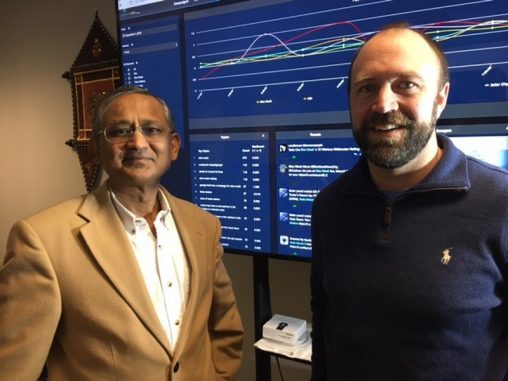
Amit Sheth, left, and James Mainord, co-founders of Cognovi Labs.
A company that predicts the future through social media. A business that pulls information from noise. Science fiction? Nope. Reality. These are examples of ideas conceived at Wright State and successfully commercialized thanks in part to the university’s fast-growing tech-transfer program.
In addition to helping launch several startup businesses, the Wright State Research Institute’s Commercialization unit and the university’s Technology Transfer Office are working on more than 25 active projects. There have been eight invention disclosures and 14 patent applications in the last year alone. The offices have also helped support entrepreneurs and startups through a multitude of programs, services and an online technology guide that includes a website and blog.
Research team finds increase in deaths from fentanyl and fentanyl analogs

Raminta Daniulaityte is associate professor and associate director of the Boonshoft School of Medicine Center for Interventions, Treatment, and Addictions Research.
A team of researchers led by the Boonshoft School of Medicine found that more than 90 percent of unintentional overdose deaths in 24 Ohio counties in January and February 2017 involved fentanyl and fentanyl analogs, while heroin was identified in only about 6 percent of cases.
Evidence from the study indicated the increasing and substantial role of illicitly manufactured fentanyl and the declining presence of heroin and pharmaceutical opioids in overdose fatalities. The study also found that fentanyl is commonly appearing in combination with other analogs.
Led by Raminta Daniulaityte, associate professor and associate director of the Boonshoft School of Medicine Center for Interventions, Treatment, and Addictions Research (CITAR), Wright State University and the Montgomery County Coroner’s Office/Miami Valley Regional Crime Lab collaborated on a National Institutes of Health/National Institute on Drug Abuse-funded study of fentanyl/fentanyl analogs and other drugs identified in 281 unintentional overdose fatalities.

Katlin Bowman, who earned her bachelor’s degree and Ph.D. in environmental sciences from Wright State, at the North Pole during a research trip measuring levels of toxic mercury in the Arctic Ocean. (Contributed photo)
Sleeping was a challenge. The sun never set for weeks at a time. And the crash of the ship’s metal hull into massive fields of ice coupled with the comings and goings of the research crew at all hours created a constant blare.
But then who needed to sleep anyway? The prospect of conducting pioneering research that could change the world’s understanding of the Arctic was a nerve-tingling stimulant for Wright State University graduate environmental sciences student Alison Agather and oceanographer Katlin Bowman, a Wright State alumna.
Both took part in a two-month expedition to the North Pole designed to take the pulse of the Arctic Ocean, measuring levels of toxic mercury in the water and ice.
Researchers attack breast cancer
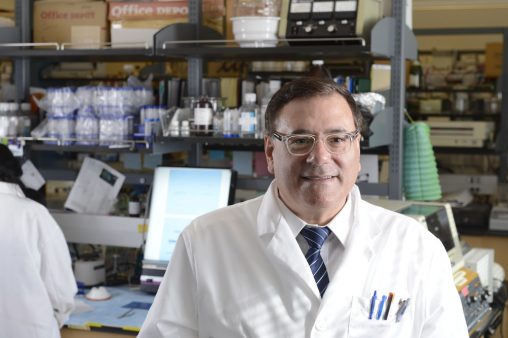
Julian Gomez-Cambronero, biochemistry and molecular biology professor at the Boonshoft School of Medicine, explores the molecular biology of tumor progression and metastasis. in breast cancer.
Researchers at the Boonshoft School of Medicine aggressively attacked breast cancer by exploring the molecular biology of tumor progression and metastasis. They are working to identify the molecules and signaling pathways that confer cancer cell aggressiveness to develop effective, targeted therapeutic drugs.
Julian Gomez-Cambronero, professor of biochemistry and molecular biology and Brage Golding Distinguished Professor of Research in the Department of Biochemistry and Molecular Biology, is working with members of his laboratory to find the molecular mechanisms that lead to breast cancer cell growth and invasiveness.
Amit Sheth honored by Ohio Faculty Council for his technology commercialization success

Amit Sheth
The Ohio Faculty Council honored Amit Sheth, LexisNexis Ohio Eminent Scholar and executive director of Wright State’s Ohio Center of Excellence in Knowledge-Enabled Computing, for his success in commercializing technology. Sheth was named runner-up in the council’s annual Technology Commercialization Award program.
The honor recognizes faculty members in the state university system in Ohio for exceptional research discoveries and the role they have played in supporting the translation of those discoveries into marketable products and services.
Twitris technology developed under the leadership and guidance of Sheth is a cloud-hosted highly scalable software system that employs a sophisticated algorithm that analyzes social big data such as those on Twitter on a massive scale to provide unprecedented insights, suggestions, actions or predicted outcomes.
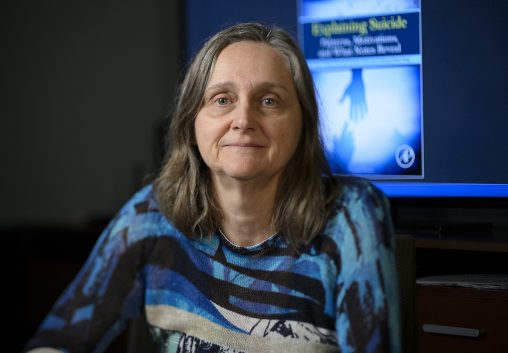
A new book co-authored by Wright State psychology professor Cheryl Meyer explores motivation for suicide by examining notes victims left behind. (Photo by Will Jones)
The last words of nearly 200 souls are snugged inside a crimson accordion folder on a bedroom floor in the home of Wright State University psychology professor Cheryl Meyer.
The suicide notes are the basis of a new book co-written by Meyer designed to unlock the mysteries of what pushes people to kill themselves, bring comfort to those touched by suicide and offer ways to prevent it.
“Explaining Suicide: Patterns, Motivations and What Notes Reveal” is written by Meyer; Taronish Irani, of The Counseling Center at SUNY Buffalo State and a Wright State alumna; Katherine Hermes, from the history department at Central Connecticut University; and the late Betty Yung, who was an associate professor of psychology at Wright State.
Researchers use gaming app to study burnout among caregivers of dementia patients

Tanvi Banerjee, assistant professor of computer science and engineering (pictured), is working with Jennifer Hughes, assistant professor of social work, to study burnout of dementia patients’ caregivers using word games, computer apps and skin sensors. (Photo by Erin Pence)
An unusual and creative approach to detecting burnout among those who care for dementia patients is being studied by Wright State University computer science and social work researchers. It involves word games, computer apps and skin sensors.
The project began in 2014 and in 2016 received a three-year, $500,000 grant from the National Institutes of Health. The study has currently tested a commercial sensor called the Hexoskin vest with 40-and-older adults and will involve as many as 20 patient/caregiver couples for a longer-term study.
Nursing educators win research grant to measure and improve teamwork

Kathy J. Keister, left, the Frederick A. White Distinguished Professor of Professional Service, and Sherry Farra, director of the National Disaster Health Consortium.
A study designed to measure and improve synergy and teamwork among nursing students in class projects and in the nursing profession is the aim of research by two Wright State University nursing educators.
Kathy J. Keister, the Crossroads Division Nurse Leader of the American Red Cross; and Sherry Farra, director of the National Disaster Health Consortium in the College of Nursing and Health, received the one-year $6,000 award from Sigma Theta Tau International, a nursing scholarship organization, and ATI Nursing Education, a noted leader in nursing education
Google selects research proposal from computer science student Matt Piekenbrock
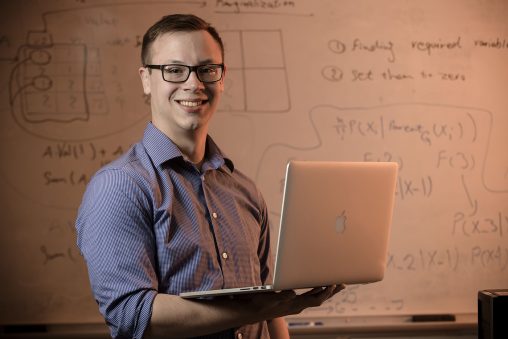
Matt Piekenbrock, a graduate computer science at Wright State, will spend his summer coding after his research project was selected in the Google Summer of Code 2017 competition. (Photo by Erin Pence)
Graduate computer science student Matt Piekenbrock wrote a successful research proposal to Google, winning the financial support of the internet-technology giant in the highly selective Google Summer of Code 2017 competition.
Piekenbrock’s research project is designed to improve the ability of computers to think on their own, enabling them to unlock mysteries hidden in large amounts of data.
Engineering students create automatic toothbrush for those unable to use their hands
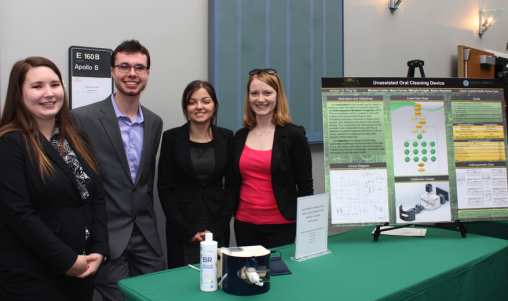
From left: Biomedical engineering students Mikayla Padgitt, Michael Collier, Skylar Rountree and Mary Farrow won the College of Engineering and Computer Science Senior Design Showcase for their automatic toothbrush.
For most people, brushing their teeth may seem like a fairly mundane task. For those with mobility issues, however, brushing their teeth may be exceedingly difficult or even impossible.
Biomedical engineering majors Michael Collier, Mary Farrow, Mikayla Padgitt and Skylar Rountree aimed to fix that with their engineering capstone project.
The students’ project, an “Unassisted Oral Cleaning Device,” is an automatic toothbrush that is connected to two motors. One rotates the toothbrush to the left and right, while the other turns the toothbrush 90 degrees to clean the sides and front of the user’s teeth. The user can activate the device by leaning forward to put their mouth around the toothbrush. The user’s shadow activates a light sensor that triggers the brushing process to begin.

 Wright State psychology team studies ways to identify fatigue in pilots, drivers
Wright State psychology team studies ways to identify fatigue in pilots, drivers  Wright State videographer Kris Sproles wins Regional Emmy and Ohio journalism award
Wright State videographer Kris Sproles wins Regional Emmy and Ohio journalism award  Wright State Boonshoft School of Medicine ranked among the nation’s best for 2024 by U.S. News
Wright State Boonshoft School of Medicine ranked among the nation’s best for 2024 by U.S. News  Exposing biotechnology
Exposing biotechnology  Wright State faculty member Dan Noel uses unique background to inspire new leaders
Wright State faculty member Dan Noel uses unique background to inspire new leaders 